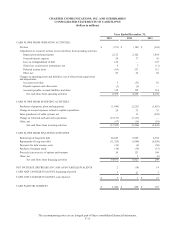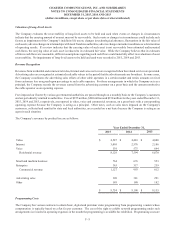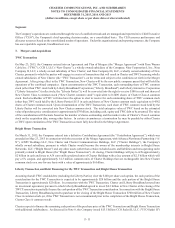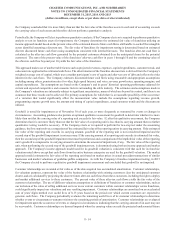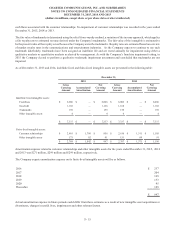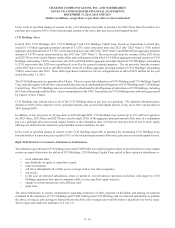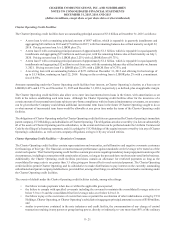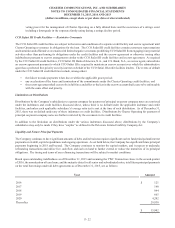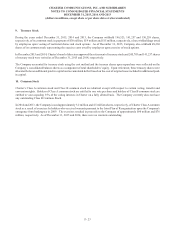Charter 2015 Annual Report Download - page 111
Download and view the complete annual report
Please find page 111 of the 2015 Charter annual report below. You can navigate through the pages in the report by either clicking on the pages listed below, or by using the keyword search tool below to find specific information within the annual report.CHARTER COMMUNICATIONS, INC. AND SUBSIDIARIES
NOTES TO CONSOLIDATED FINANCIAL STATEMENTS
DECEMBER 31, 2015, 2014 AND 2013
(dollars in millions, except share or per share data or where indicated)
F- 14
the Company concluded that it is more likely than not that the fair value of the franchise assets in each unit of accounting exceeds
the carrying value of such assets and therefore did not perform a quantitative analysis.
Periodically, the Company will elect to perform a quantitative analysis. If the Company elects or is required to perform a quantitative
analysis to test its franchise assets for impairment, the Company determines the estimated fair value of franchises utilizing an
income approach model based on the present value of the estimated discrete future cash flows attributable to each of the intangible
assets identified assuming a discount rate. The fair value of franchises for impairment testing is determined based on estimated
discrete discounted future cash flows using assumptions consistent with internal forecasts. The franchise after-tax cash flow is
calculated as the after-tax cash flow generated by the potential customers obtained (less the anticipated churn for the potential
customer). The sum of the present value of the franchises' after-tax cash flow in years 1 through 10 and the continuing value of
the after-tax cash flow beyond year 10 yields the fair value of the franchises.
This approach makes use of unobservable factors such as projected revenues, expenses, capital expenditures, customer trends, and
a discount rate applied to the estimated cash flows. The determination of the franchise discount rate is derived from the Company's
weighted average cost of capital, which uses a market participant’s cost of equity and after-tax cost of debt and reflects the risks
inherent in the cash flows. The Company estimates discounted future cash flows using reasonable and appropriate assumptions
including among others, penetration rates for video, high-speed Internet, and voice; revenue growth rates; operating margins; and
capital expenditures. The assumptions are based on the Company’s and its peers’ historical operating performance adjusted for
current and expected competitive and economic factors surrounding the cable industry. The estimates and assumptions made in
the Company’s valuations are inherently subject to significant uncertainties, many of which are beyond its control, and there is no
assurance that these results can be achieved. The primary assumptions for which there is a reasonable possibility of the occurrence
of a variation that would significantly affect the measurement value include the assumptions regarding revenue growth,
programming expense growth rates, the amount and timing of capital expenditures, actual customer trends and the discount rate
utilized.
Goodwill is tested for impairment as of November 30 of each year, or more frequently as warranted by events or changes in
circumstances. Accounting guidance also permits an optional qualitative assessment for goodwill to determine whether it is more
likely than not that the carrying value of a reporting unit exceeds its fair value. If, after this qualitative assessment, the Company
determines that it is not more likely than not that the fair value of a reporting unit is less than its carrying amount then no further
quantitative testing would be necessary. If the Company elects or is required to perform the two-step test under the accounting
guidance, the first step involves a comparison of the estimated fair value of the reporting unit to its carrying amount. If the estimated
fair value of the reporting unit exceeds its carrying amount, goodwill of the reporting unit is not considered impaired and the
second step of the goodwill impairment is not necessary. If the carrying amount of a reporting unit exceeds its estimated fair value,
then the second step of the goodwill impairment test must be performed, and a comparison of the implied fair value of the reporting
unit’s goodwill is compared to its carrying amount to determine the amount of impairment, if any. The fair value of the reporting
unit, when performing the second step of the goodwill impairment test, is determined using both an income approach and market
approach. The Company's income approach model used for its goodwill valuation is consistent with that used for its franchise
valuation noted above except that cash flows from the entire business enterprise are used for the goodwill valuation. The market
approach model estimates the fair value of the reporting unit based on market prices in actual precedent transactions of similar
businesses and market valuations of guideline public companies. As with the Company's franchise impairment testing, in 2015
the Company elected to perform a qualitative goodwill impairment assessment and concluded that goodwill is not impaired.
Customer relationships are recorded at fair value as of the date acquired less accumulated amortization. Customer relationships,
for valuation purposes, represent the value of the business relationship with existing customers (less the anticipated customer
churn), and are calculated by projecting the discrete future after-tax cash flows from these customers, including the right to deploy
and market additional services to these customers. The present value of these after-tax cash flows yields the fair value of the
customer relationships. The use of different valuation assumptions or definitions of franchises or customer relationships, such as
our inclusion of the value of selling additional services to our current customers within customer relationships versus franchises,
could significantly impact our valuations and any resulting impairment. Customer relationships are amortized on an accelerated
sum of years' digits method over useful lives of 8-15 years based on the period over which current customers are expected to
generate cash flows. The Company periodically evaluates the remaining useful lives of its customer relationships to determine
whether events or circumstances warrant revision to the remaining periods of amortization. Customer relationships are evaluated
for impairment upon the occurrence of events or changes in circumstances indicating that the carrying amount of an asset may not
be recoverable. Customer relationships are deemed impaired when the carrying value exceeds the projected undiscounted future




